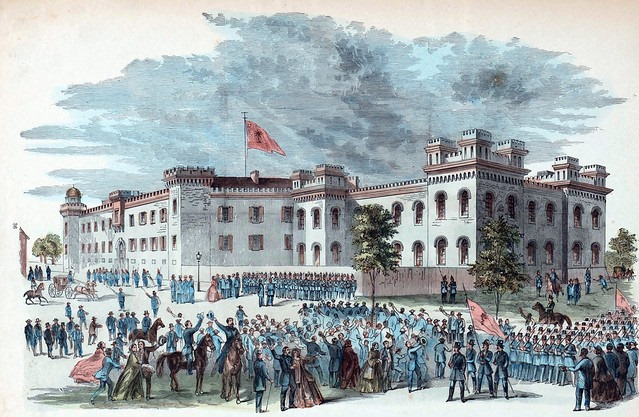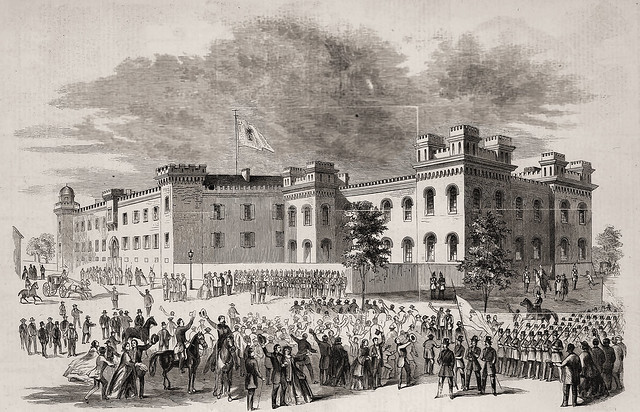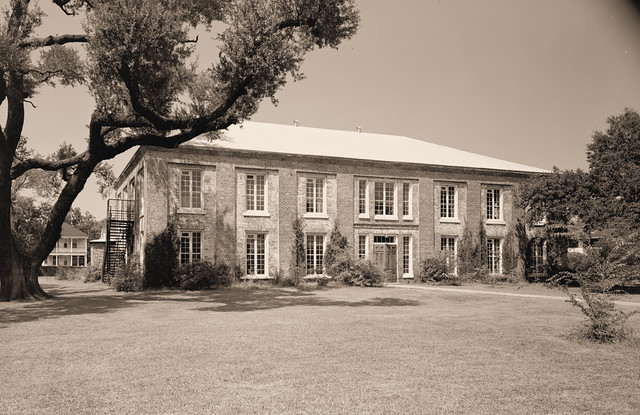
This is an artist’s imagined rendering of an actual event that wasn’t much of an event.
From the c1875 engraved print:
United States Arsenal at Charleston, S.C. Seized by the State Authorities, December 28th, 1860
“At the time this picture was drawn the handsome arsenal of the government at Charleston was an object of great interest. An immense amount of ammunition was stored there, and raids upon it were expected at any moment. It was watched and guarded with great care by detachments of the Washington Light Infantry. It was afterward seized by the State authorities.”
The image was originally published as “The Government Arsenal in Charleston, S. C., Guarded by Detachments of the Washington Light Infantry. – From a Sketch by our Special Artist” in the December 1, 1860 issue of Frank Leslie’s Illustrated Newspaper.

The building in this image is a representation of the “old Arsenal.” At the end of 1860, the building was part of The Citadel, a military college. Now an Embassy Suites, the old Citadel was built in 1829 to operate as the State Arsenal. After some disagreement between the state and the Federal Government, a proposal was made to use the facilities as a military academy and the Citadel Academy opened in March of 1843.
A “new” federal arsenal was built less than a mile away. This is the facility that South Carolina troops “seized,” though seizure is a bit of an exaggeration since the facility had been jointly guarded by U.S. troops and S.C. militia. since at least November 20, when Brevet-Colonel Benjamin Hugar arrived to take command.

In her diary, Mary Boykin Chesnut wrote on December 27, “A letter from Susan Rutledge: ‘Captain Humphrey folded the United States Army flag just before dinnertime. Ours was run up in its place. You know the Arsenal is in sight. What is the next move?’
F. C. Humphreys was the commanding officer of military storekeeper ordinance at the arsenal before the arrival of Hugar.
According to the Medical College of South Carolina which purchased the site of the arsenal in 1963:
On November 7, 1860, Charleston militia seized the Federal Arsenal making it one of the first Federal properties taken by the Confederacy during the Civil War.
South Carolina Governor Francis Wilkinson Pickens ordered the State militia to surround the federal arsenal.
“On the 7th instant I received an order from Colonel Gardner, commanding troops in the harbor, to issue to him all of the fixed ammunition for small-arms (percussion caps, primers, &c) at this arsenal, such a step being advisable, in his estimation, for the better protection of the property in view of the excitement now existing in this city and State. Being allowed no discretion in the matter, his order being peremptory, I proceed to obey it on the afternoon of the 8th.”
Frederick C. Humphrey, Military Storekeeper Ordnance, Commanding, to C.H.K. Craig, Chief of Ordnance, U.S.A., Washington, D.C., November 10, 1860″
The arsenal remained under guard by both Federal and South Carolina troops until December 30, 1860, at which time the South Carolina militia surrounded the arsenal and demanded its immediate surrender.
“Charleston, December 30, 1860 – 10½ o’clock a.m.”
“Sir: I herewith demand an immediate surrender of the U.S. Arsenal at this place and under your charge, and a delivery to me of the keys and contents of the arsenals, magazines, &c. I am already proceeding to occupy it with a strong armed detachment of troops. I make the demand in the name of the State of South Carolina, and by virtue of an order from its governor, a copy of which is inclosed.
” Very respectfully,
” John Cunningham
” Colonel Seventeenth Reg. Inf., S.C.M.
————————————————–
“Sir: This arsenal has to-day been taken by force of arms. What disposition am I to make of my command?”
Frederick C. Humphreys to Capt. Maynadier, In charge of Ordnance Bureau, Charleston, S.C., December 30, 1860
Federal troops withdrew from the arsenal and relocated to Fort Sumter.